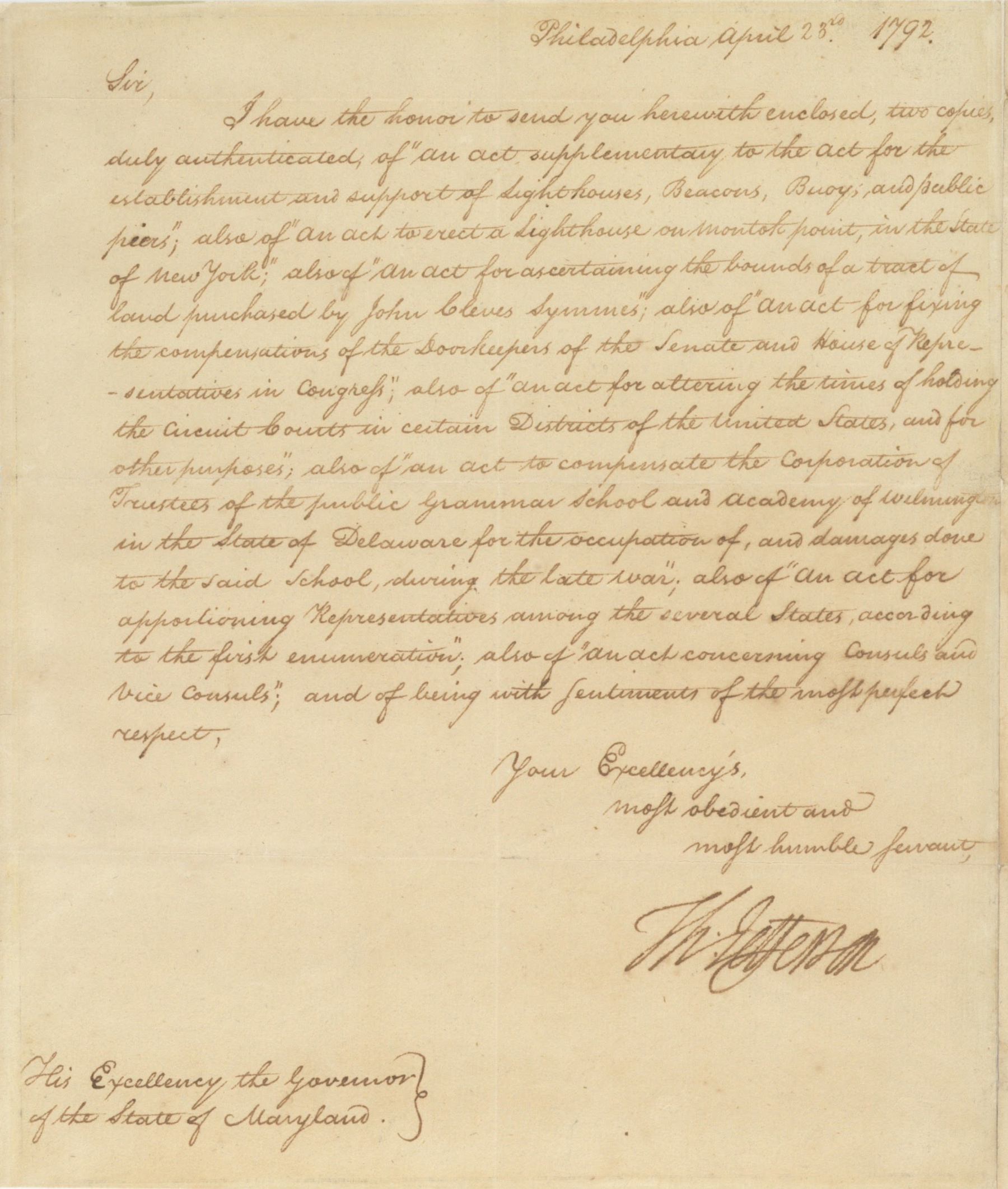Thomas Jefferson Sends the First Act Setting in Place Congressional Representation in the House of Representatives




The Act mandated the “Apportioning Representatives among the several States” based on the Result of the First U.S. Census in 1790
- Currency:
- USD
- GBP
- JPY
- EUR
- CNY
Interestingly, the method of apportioning was developed by Jefferson himself and was called the Jefferson Method
Jefferson also transmitted a series of other laws newly passed
Article 1, Section 2, Clause 3 or the U.S. Constitution provided the first apportionment of seats in the House of Representatives and stipulated that a...
Interestingly, the method of apportioning was developed by Jefferson himself and was called the Jefferson Method
Jefferson also transmitted a series of other laws newly passed
Article 1, Section 2, Clause 3 or the U.S. Constitution provided the first apportionment of seats in the House of Representatives and stipulated that a Census (“enumeration”) of the population of the states must be made within three years of the first meeting of Congress. The apportionment of seats in the House was to be effected on the basis of population, with each state entitled to at least one representative. In accordance with the Constitution, in 1790 Congress passed the First Census Act, which required that the enumeration begin on Monday, August 2, 1790, and be conducted by marshals of the U.S. judicial districts. According to the legislation, the marshals were tasked with visiting every household, posting completed census schedules in public places within each jurisdiction, and sending the President the aggregate amount. When complete, the census showed the aggregate population of the United States at 3,929,214.
“An Act apportioning Representatives among the several States according to the first enumeration”, meeting the Constitutional requirement and also known as the Apportionment Act of 1792, was the first such act passed by the U.S. Congress, and it was signed into law by President George Washington on April 14, 1792. The Act set the number of members of the House of Representatives at 105, effective on March 4, 1793, and established that a number of representatives would be allotted to each state based on the population enumeration provided by the 1790 Census. The distribution of members by state was: New Hampshire, 4; Massachusetts, 14; Vermont, 2; Rhode Island, 2; Connecticut, 7; New York, 10; New Jersey, 5; Pennsylvania, 13; Delaware, 1; Maryland, 8; Virginia, 19; Kentucky, 2; North Carolina, 10; South Carolina, 6; and Georgia, 2. The method of allocation used was devised by Secretary of State Thomas Jefferson, and is called the Jefferson Method. It required fractional remainders to be ignored when calculating each state’s total number of representatives, and worked on the basis of “the ratio of one for every thirty-three thousand persons in the respective States”.
In the Washington administration, copies of new laws – passed by Congress and signed by the President – were sent as official notifications by the Secretary of State to the state governors. This is one such letter. Letter signed by Jefferson as Secretary of State, Philadelphia, April 23, 1792, to the Governor of Maryland, Thomas Sim Lee, transmitting a series of laws recently passed, including the one apportioning Representatives among the several states. “I have the honor to send you herewith enclosed two copies duly authenticated of ‘an act supplementary to the act for the establishment and support of lighthouses, beacons, buoy, and public piers’; also of ‘an act to erect a lighthouse on Montauk Point in the state of New York’; also “an act for ascertaining the bounds of a tract of land purchased by John Cleves Symmes’; also an act for fixing the compensations of the doorkeepers of the Senate and House of Representatives in Congress’; also ‘an act for altering the times of holding the Circuit Courts in certain districts of the United States, and for other purposes’; also aan act to compensate the Corporation of Trustees of the public grammar school and academy of Wilmington in the state of Delaware for the occupation done and damages to the said school during the late war’ also of ‘an act of apportioning Representatives among the several States according to the first enumeration’; also of ‘an act concerning consuls and vice consuls’; and being with sentiments of the most perfect respect…Thomas Jefferson.”
John Cleves Symmes was a delegate to the Continental Congress from New Jersey, and later a pioneer in the Northwest Territory. The “late war” referenced is the Revolutionary War; and although no battles occurred in Wilmington, it was the site of military action during the Battle of Cooch’s Bridge in 1777.
A significant letter relating to important provisions of the Constitution, the organization of the House of Representatives, and the first census.

Frame, Display, Preserve
Each frame is custom constructed, using only proper museum archival materials. This includes:The finest frames, tailored to match the document you have chosen. These can period style, antiqued, gilded, wood, etc. Fabric mats, including silk and satin, as well as museum mat board with hand painted bevels. Attachment of the document to the matting to ensure its protection. This "hinging" is done according to archival standards. Protective "glass," or Tru Vue Optium Acrylic glazing, which is shatter resistant, 99% UV protective, and anti-reflective. You benefit from our decades of experience in designing and creating beautiful, compelling, and protective framed historical documents.
Learn more about our Framing Services














































































































